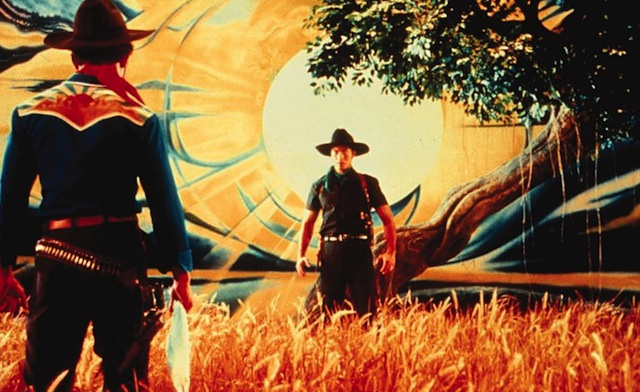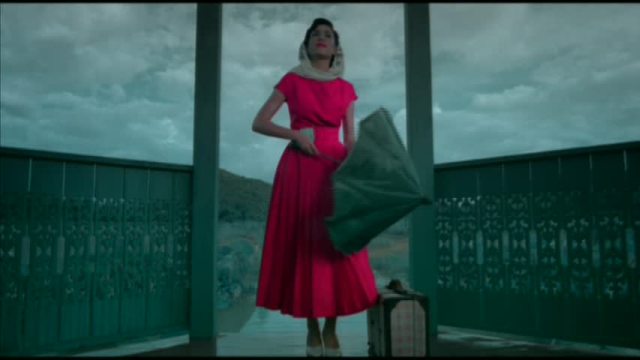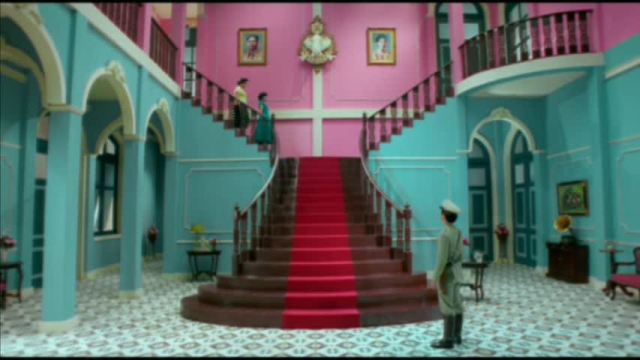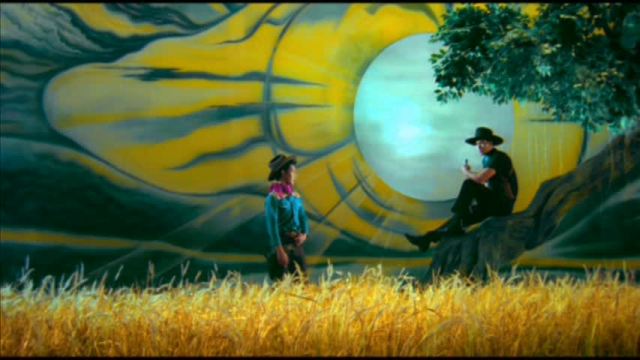Artifice, emotion, and truth

Strangely enough, the genre description “deliberately artificial romantic melodrama slash Thai western” don’t do justice to Wisit Sasanatieng’s 2000 film Tears of the Black Tiger. The film is a postmodern pastiche of the most shallow and wonderful kind: ambitious, energetic, and entertaining, combining disparate clichés, both narrative and visual, to form something new and unique.
When the film opens, Dum (pronounced like Dahm, so it’s not really that funny) and Mahesuan, two gunmen dressed like parodies of cowboy tourists, assault a country house, shooting and killing everyone inside. We learn that Dum, the eponymous Black Tiger, and Mahesuan are the right hand men of Fai, an outlaw whose band terrorizes the Thai countryside. Meanwhile, a young woman, Rumpoey, waits in a lagoon gazebo for someone who never arrives; when she gazes at a photograph of the lover who has jilted her, we see it is Dum. Dum arrives too late for their rendezvous, and Rumpoey returns home to be engaged to Kumjorn, a respectable and ambitious police captain.

Rumpoey at the gazebo
Kumjorn, eager to prove himself, suggests to Rumpoey’s father, the governor, an attack on Fai and his men. The attack goes well for the police — that is, until Dum and Mahesuan return from a night of drunken revelry, in which they pledged blood brotherhood to each other. Kumjorn is captured, but Dum takes pity on him and lets him escape when he learns Kumjorn is betrothed to Rumpoey. Obviously, this sets in motion a love triangle between Dum, Kumjorn, and Rampoey, and sets Dum and Mahesuan against each other when Fai becomes suspicious of the infamous Black Tiger’s motives.
In classic melodramatic tradition, the plot is both deceptively simple and convoluted, as my description might suggest — and it leaves out the last third of the movie, as well as the flashback sequences where we learn how Dum and Rumpoey first met and fell in love. It trades in familiar narrative tropes and character types: the love triangle, romance between different social classes, the honorable outlaw, brothers (actual or figurative) set against one another by fate. Complementing those well-tread narrative pathways, Tears of the Black Tiger utilizes an expressive and inventive aesthetic cobbled together from past visual styles. The bright, saturated color schema and slight haze recalls the cheap color systems used in imitation of Technicolor by Indian and other Asian cinemas of the 50s, 60s, and 70s. The garish red of the blood reminds one of the thick splashes of Hammer horror films. The musical leitmotif that follows the outlaw cowboys imitates Ennio Morricone’s Western themes, while the scenes between Dum and Rumpoey feature Max Steiner-like romantic swells.

Bright sets recall older modes of design
The purpose of this pastiche seems to be the deliberate interrogation of older styles and forms of filmmaking. The artifice commonplace to classical filmmaking, but passé now — sets used for outdoor locations, over-emotive performances, rear projection driving — are not only used in Tears of the Black Tiger, but made blindingly obvious to the viewer. The flashback to Dum and Rumpoey’s childhood even begins with a sequence that parodies silent film parodies, complete with overcranked projector speed, missing frames, and artificially induced dust and scratches.
A scene between Dum and Rumpoey as children offers a possible answer to the questions raised. At the gazebo where Rumpoey will later wait for him, only to be disappointed, Dum tells her a folktale about the builder of the gazebo. He was a woodcutter who fell in love with a wealthy girl, and built the structure as a monument to her beauty. When the girl’s father learned of her plan to run away and marry the woodcutter, he locked her away in their house, where she hanged herself in despair. Obviously the folktale is meant to resonate with the film’s main storyline of a socially unacceptable pairing and its potential for a tragic conclusion. I would offer, however, that this scene is key to understanding the film as a broader piece of work. Its relationship to older models of filmmaking casts them as a kind of folktale storytelling, not meant to be naturalistic, but rather to conjure up modes of feeling and aesthetic appreciation unrelated to the quotidian modern. Those moments of artifice and of cinematic excess are clues to the viewer, telling us this is just a story, and just as the film echoes Dum’s folktale, attesting to its lessons, Tears of the Black Tiger evokes the cinematic past to remind us of the truths embedded therein.

The interior-exterior as expressive truth
—
Adam Capitanio lives and works in New York City as an editor and educator. He’s happy to talk to you about any dimension of film art and culture.